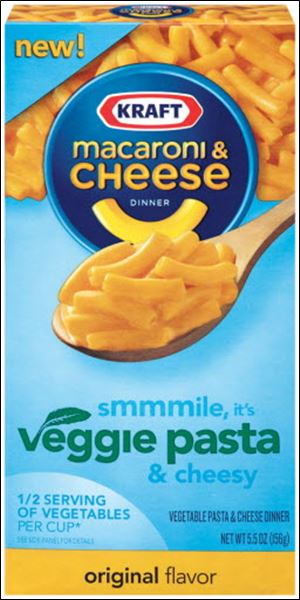
Kraft, other companies, camouflage cauliflower
7/12/2011
In an effort to ride a renewed interest in healthy eating to fatter profits, Kraft started stocking Kraft Macaroni & Cheese Dinner Veggie Pasta. Every neon-orange cup serving packs a half-serving of cauliflower.
It looks like Kraft Macaroni & Cheese, and Kraft says it tastes just like the original. But a new ingredient is lurking inside this version of the American family dinner staple -- cauliflower.
Don't tell the kids!
Kraft Foods Inc. is the latest large food manufacturer to try hiding additional veggies in packaged foods, an effort to ride a renewed interest in healthy eating to fatter profits. It's a slowly growing trend, and it's one that is dividing food industry experts.
In June, stores started stocking Kraft Macaroni & Cheese Dinner Veggie Pasta. Every neon-orange cup serving of the new recipe packs a half-serving of cauliflower.
Kraft joins brands such as ConAgra Foods Inc.'s Chef Boyardee, which includes enough tomato in some of its canned pasta to claim half a cup of vegetables per serving, and Unilever's Ragu pasta sauces, which says it has two servings of veggies for every half cup of sauce.
In the Kraft product, the company freeze-dries cauliflower and pulverizes it into a powder, then uses that powder to replace some of the flour in the pasta.
Kraft's move is a variation on a theme espoused by several recent cookbooks. Missy Chase Lapine is author of the Sneaky Chef series of cookbooks, in which she promotes a system of color-coded, pureed fresh and frozen fruits and vegetables that can be mixed into foods such as macaroni and cheese (yams or cauliflower), spaghetti (carrots and sweet potato), and brownies (baby spinach and blueberries).
"The ideal, of course, is you steam up some local, organic, freshly picked cauliflower, and your child eats it outright with a little mist of olive oil, happily," Ms. Lapine said.
But like Kraft, Lapine takes a practical approach. "Food is only healthy if you can get someone to eat it," she said.
Harry Balzer, who tracks Americans' eating patterns for The NPD Group, a market research firm, says parents are making genuine attempts to get healthier foods into their kids. Fruits now make up 6 percent of kids' diets, the largest share since he started tracking kids' consumption 30 years ago.
But vegetables, which peaked as a percentage of kids' diets in 1984, remain a sticking point. They're a hassle for parents to buy and keep fresh, they're not generally seen as snack foods the way fruits are, and they're rarely served alone as a main dish. That means if someone is cooking at home, vegetables are added work. And when they are available, many kids simply aren't biting, the analyst said.
For Phil Lempert, another food industry analyst, half a serving of cauliflower in the new Kraft Macaroni & Cheese is better than nothing if Americans are willing to serve it.
That approach draws skepticism from Marion Nestle, a professor at New York University's department of nutrition, food studies and public health. Nutrients are lost when vegetables are freeze-dried, Ms. Nestle says, and people are also losing the benefit of greater volume of less calorie-dense food in a meal.
"Oh, what will they think of next," Ms. Nestle said. "What a silly idea."